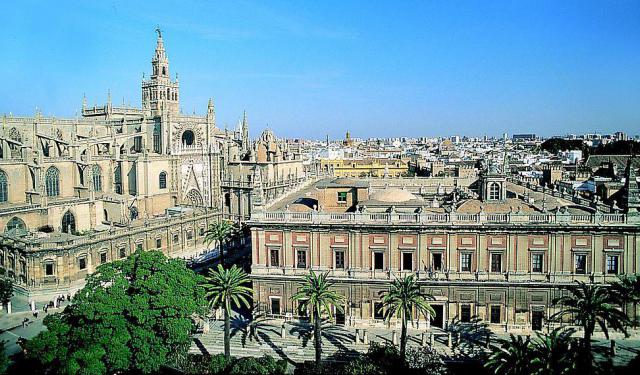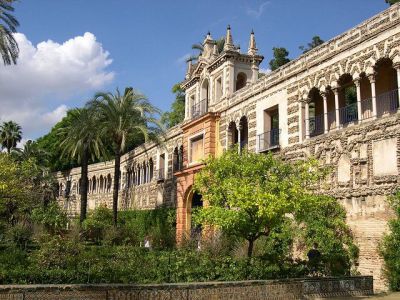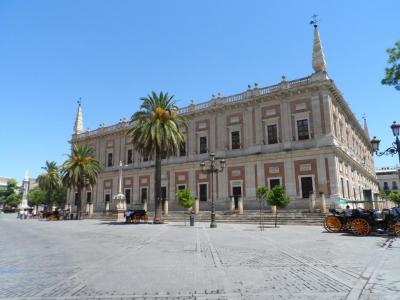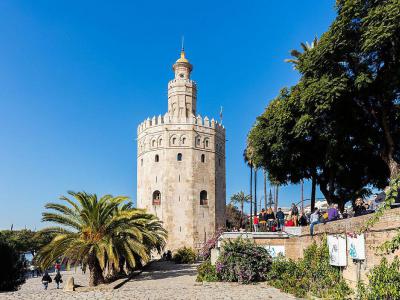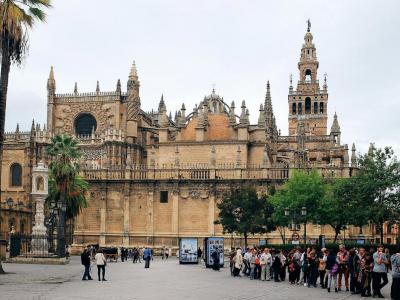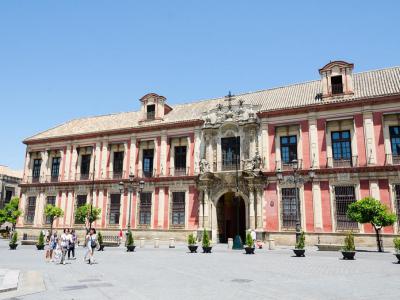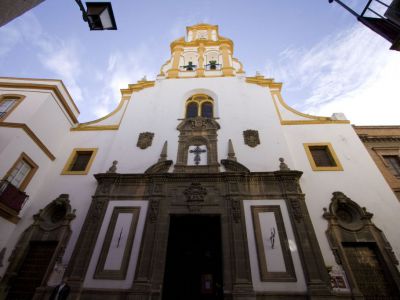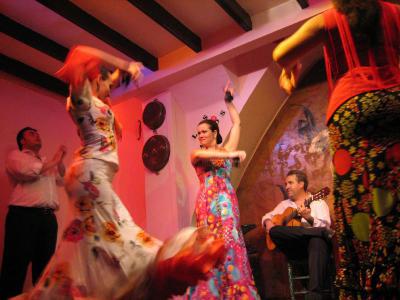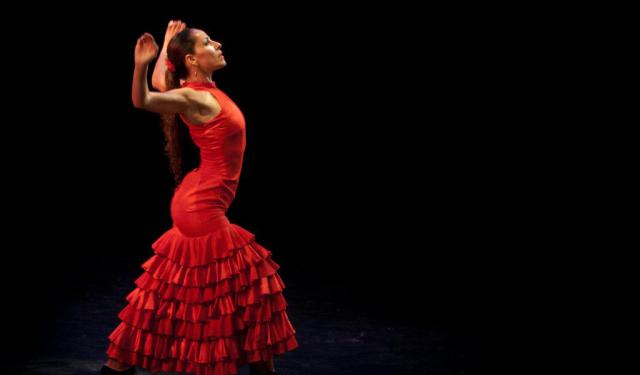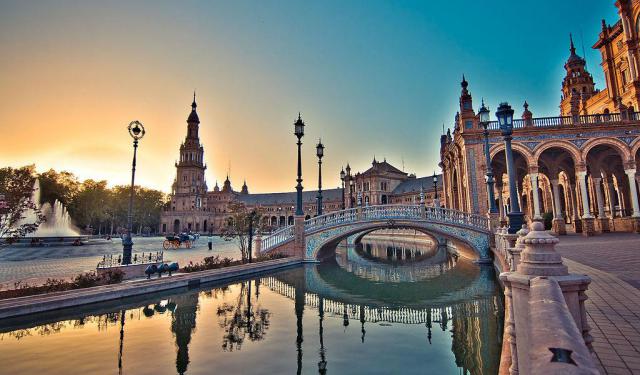Old Seville Walking Tour (Self Guided), Seville
Seville's varied history has left behind a great deal of heritage, much of which is seen in the Old Town, the largest in Europe. Barrio de Santa Cruz is the former Jewish quarter of Seville, and one of the famous districts here. From 1248 to 1492, it had been inhabited by the largest Jewish community in Spain – eventually driven out, leaving this beautiful neighborhood forlorn.
Today the Old Town of Seville is just as splendid as ever. A maze of narrow streets and alleys, leading to the majestic palaces in Spanish and Moorish styles, and the lovely squares lined with houses, painted in dark brick, ochre, cream and other distinctive colors of Spanish south, attract a steady flow of tourists year after year. Here are some of the top locations not to be missed:
Real Alcazar de Sevilla – the 10th-century Royal Palace and a key landmark of Seville, featuring a mix of Moorish and Christian influences; the name 'Alcazar' means castle.
Archivo General de Indias – the Archive of the Indies, located in the late 16th-century edifice, first used as a trading house until 1785.
Plaza de toros de la Maestranza – the most important bullring in Spain; the 18th-century arena boasts a unique Baroque façade, and is home to the world's largest bullfighting festival.
Seville Cathedral & Giralda Tower – an impressive Cathedral built over the Great Mosque in the 14th century.
Hospital de los Venerables – a 17th-century Baroque building which once served as a residence for priests; currently houses the Velázquez Center, dedicated to the famous painter Diego Velázquez.
To explore these and other monumental sights of Old Seville in more detail, and to discover traces of its rich historical background, check out this self-guided walking tour.
Today the Old Town of Seville is just as splendid as ever. A maze of narrow streets and alleys, leading to the majestic palaces in Spanish and Moorish styles, and the lovely squares lined with houses, painted in dark brick, ochre, cream and other distinctive colors of Spanish south, attract a steady flow of tourists year after year. Here are some of the top locations not to be missed:
Real Alcazar de Sevilla – the 10th-century Royal Palace and a key landmark of Seville, featuring a mix of Moorish and Christian influences; the name 'Alcazar' means castle.
Archivo General de Indias – the Archive of the Indies, located in the late 16th-century edifice, first used as a trading house until 1785.
Plaza de toros de la Maestranza – the most important bullring in Spain; the 18th-century arena boasts a unique Baroque façade, and is home to the world's largest bullfighting festival.
Seville Cathedral & Giralda Tower – an impressive Cathedral built over the Great Mosque in the 14th century.
Hospital de los Venerables – a 17th-century Baroque building which once served as a residence for priests; currently houses the Velázquez Center, dedicated to the famous painter Diego Velázquez.
To explore these and other monumental sights of Old Seville in more detail, and to discover traces of its rich historical background, check out this self-guided walking tour.
How it works: Download the app "GPSmyCity: Walks in 1K+ Cities" from Apple App Store or Google Play Store to your mobile phone or tablet. The app turns your mobile device into a personal tour guide and its built-in GPS navigation functions guide you from one tour stop to next. The app works offline, so no data plan is needed when traveling abroad.
Old Seville Walking Tour Map
Guide Name: Old Seville Walking Tour
Guide Location: Spain » Seville (See other walking tours in Seville)
Guide Type: Self-guided Walking Tour (Sightseeing)
# of Attractions: 8
Tour Duration: 2 Hour(s)
Travel Distance: 2.6 Km or 1.6 Miles
Author: emma
Sight(s) Featured in This Guide:
Guide Location: Spain » Seville (See other walking tours in Seville)
Guide Type: Self-guided Walking Tour (Sightseeing)
# of Attractions: 8
Tour Duration: 2 Hour(s)
Travel Distance: 2.6 Km or 1.6 Miles
Author: emma
Sight(s) Featured in This Guide:
- Real Alcazar de Sevilla (Royal Palace of Seville)
- Archivo General de Indias (Archive of the Indies)
- Torre del Oro (Gold Tower)
- Plaza de toros de la Maestranza (Maestranza Bullring)
- Seville Cathedral & Giralda Tower
- Palacio Arzobispal (Archbishop's Palace)
- Iglesia de Santa Cruz (Church of Santa Cruz)
- Los Gallos Tablao Flamenc
1) Real Alcazar de Sevilla (Royal Palace of Seville) (must see)
In the year 712, Seville was conquered by the Umayyad Caliphate. Then began 700 years of Arab rule in Andalusia. In 913 Abd al-Rahman III built a fort over a Visigothic church.
This construction was expanded in the 11th century by an addition called "Al Mubarak", The Blessed. Seville became the capital of Al-Andalus and there followed a period of demolishing and rebuilding until twelve palaces had been built one over the other. In 1366 Pedro I built Mudejar Palace. Ferdinand and Isabella made the top floor the royal residence.
Styles followed one another over the years until no hint remained of the original design. They refashioned with Islamic, Gothic, Romanesque and Renaissance influences. Then came Baroque, with Islamic overtones. Did we mention tiles? Majolica and arista? Ceramic tiles, Seville had more than anyone. More cigars and more tiles.
La Puerta de Leon (Lion Gate) is the main gate to the palace. It is named for the tile inlay above the entrance depicting a lion holding a cross and a banner in Latin which could be translated as "ready for anything". With all the architectural changes to the palace since 913, the scroll is true wit.
Visit the gardens. All the old Andalusian palaces had gardens which featured fruit trees, vegetables and flowers. They not only provided food but also visual and esthetic pleasure. Water was plentiful in fountains and ponds. In the 16th century the old Muslim wall was turned into a loggia to admire the view of the palace gardens.
Must see items in the palace are the patios and rooms. Some of the names are intriguing. Courtyard of the Dolls, Bedroom of the Moorish Kings, Justice Room, Prince's Room, Courtyard of the Maidens, and there are at least thirteen gardens.
This construction was expanded in the 11th century by an addition called "Al Mubarak", The Blessed. Seville became the capital of Al-Andalus and there followed a period of demolishing and rebuilding until twelve palaces had been built one over the other. In 1366 Pedro I built Mudejar Palace. Ferdinand and Isabella made the top floor the royal residence.
Styles followed one another over the years until no hint remained of the original design. They refashioned with Islamic, Gothic, Romanesque and Renaissance influences. Then came Baroque, with Islamic overtones. Did we mention tiles? Majolica and arista? Ceramic tiles, Seville had more than anyone. More cigars and more tiles.
La Puerta de Leon (Lion Gate) is the main gate to the palace. It is named for the tile inlay above the entrance depicting a lion holding a cross and a banner in Latin which could be translated as "ready for anything". With all the architectural changes to the palace since 913, the scroll is true wit.
Visit the gardens. All the old Andalusian palaces had gardens which featured fruit trees, vegetables and flowers. They not only provided food but also visual and esthetic pleasure. Water was plentiful in fountains and ponds. In the 16th century the old Muslim wall was turned into a loggia to admire the view of the palace gardens.
Must see items in the palace are the patios and rooms. Some of the names are intriguing. Courtyard of the Dolls, Bedroom of the Moorish Kings, Justice Room, Prince's Room, Courtyard of the Maidens, and there are at least thirteen gardens.
2) Archivo General de Indias (Archive of the Indies)
Archivo General de Indias, also known as the General Archive of the Indies, is located near Plaza del Triunfo in central Seville. The archive was created in 1785 as a place to hold all documentation regarding the country's overseas territories, though the building has a history that dates to 1646.
The building was designed by architect Juan de Herrera. It was used as a center of commerce for the city. Other architects, including Alonso de Vandelvira and Miguel de Zumarraga, aided Herrera in designing a building that was resistant to fires, which was a common issue at the time.
King Carlos III reinvented the building as a place to hold important documentation relating to possessions in the Americas. Seville was chosen for this, in part, because the city was the sole trade port in Spain for the New World.
Visitors may explore that archives on Tuesday through Saturday from 9.30 AM to 4:45 PM. The building is open on Sundays from 10 AM to 1:45 PM. It is closed on Mondays and certain holidays. Admission is free.
Tip:
One of the most interesting exhibits is on the ground floor – the 1616 cannon from the "Nuestra Señora de Atocha" which was a treasure-laden ship that sank in a storm on the way back to Spain from Havana. This exhibit is enough to make the visit memorable – don't miss it!
The building was designed by architect Juan de Herrera. It was used as a center of commerce for the city. Other architects, including Alonso de Vandelvira and Miguel de Zumarraga, aided Herrera in designing a building that was resistant to fires, which was a common issue at the time.
King Carlos III reinvented the building as a place to hold important documentation relating to possessions in the Americas. Seville was chosen for this, in part, because the city was the sole trade port in Spain for the New World.
Visitors may explore that archives on Tuesday through Saturday from 9.30 AM to 4:45 PM. The building is open on Sundays from 10 AM to 1:45 PM. It is closed on Mondays and certain holidays. Admission is free.
Tip:
One of the most interesting exhibits is on the ground floor – the 1616 cannon from the "Nuestra Señora de Atocha" which was a treasure-laden ship that sank in a storm on the way back to Spain from Havana. This exhibit is enough to make the visit memorable – don't miss it!
3) Torre del Oro (Gold Tower)
The Gold Tower, situated in Seville, is a twelve-sided military watchtower constructed by the Almohad dynasty to control access to Seville via the Guadalquivir river. It was built in the early 13th century and had a role as a prison during the Middle Ages. Its name originates from the radiant golden reflection it cast on the river, attributed to its construction materials, which consisted of a blend of mortar, lime, and compacted hay.
This tower is divided into three levels, with the third and uppermost level being circular in shape, added in 1769. Nearby, there is a smaller octagonal tower known as the Silver Tower, believed to have been built during the same era.
In recent centuries, the Gold Tower faced a threat when the adjacent road needed expansion. However, due to strong opposition from the local population, the idea of demolishing the tower was abandoned. In 1868, there was an attempt to sell it as scrap, but this proposal was also vehemently rejected by the city's residents. Today, the tower has been restored and serves as a naval museum, housing engravings, letters, models, instruments, and historical documents. The museum provides insights into the naval history of Seville and the significance of its river.
This tower is divided into three levels, with the third and uppermost level being circular in shape, added in 1769. Nearby, there is a smaller octagonal tower known as the Silver Tower, believed to have been built during the same era.
In recent centuries, the Gold Tower faced a threat when the adjacent road needed expansion. However, due to strong opposition from the local population, the idea of demolishing the tower was abandoned. In 1868, there was an attempt to sell it as scrap, but this proposal was also vehemently rejected by the city's residents. Today, the tower has been restored and serves as a naval museum, housing engravings, letters, models, instruments, and historical documents. The museum provides insights into the naval history of Seville and the significance of its river.
4) Plaza de toros de la Maestranza (Maestranza Bullring) (must see)
The Plaza de Toros de la Maestranza is Spain's oldest bullring and is associated with the Real Maestranza de Caballería de Sevilla, a venerable guild dedicated to traditional cavalry training. It serves as the venue for one of the world's most renowned bullfighting festivals during the annual Seville Fair in Seville.
The bullring itself is among the city's most popular tourist attractions, drawing a significant number of visitors. It is considered a particularly challenging arena for bullfighting due to its historical significance, unique features, and a demanding audience that is known to be unforgiving among bullfighting enthusiasts.
In Seville, bullfights during the Feria de Abril represent the highlight of the city's bullfighting calendar. The regular bullfighting season typically runs from March or April (depending on the dates of Semana Santa) until late September. Each year, the Real Maestranza commissions a painter to create a poster announcing the bullfighting season at its Royal Bullring.
Regular tours are available for visitors to explore the Bullring and its associated Museum, providing a genuine sense of what both the bull and the bullfighter experience. It's worth noting that you don't need to be a bullfighting enthusiast to find these tours and the history of the place intriguing.
Tip:
If you go on a Sunday to attend a bullfight, make sure you buy tickets in the shade. Don't bring huge hats – you'll probably be asked by irate patrons behind you to take it off since its blocking their view.
The bullring itself is among the city's most popular tourist attractions, drawing a significant number of visitors. It is considered a particularly challenging arena for bullfighting due to its historical significance, unique features, and a demanding audience that is known to be unforgiving among bullfighting enthusiasts.
In Seville, bullfights during the Feria de Abril represent the highlight of the city's bullfighting calendar. The regular bullfighting season typically runs from March or April (depending on the dates of Semana Santa) until late September. Each year, the Real Maestranza commissions a painter to create a poster announcing the bullfighting season at its Royal Bullring.
Regular tours are available for visitors to explore the Bullring and its associated Museum, providing a genuine sense of what both the bull and the bullfighter experience. It's worth noting that you don't need to be a bullfighting enthusiast to find these tours and the history of the place intriguing.
Tip:
If you go on a Sunday to attend a bullfight, make sure you buy tickets in the shade. Don't bring huge hats – you'll probably be asked by irate patrons behind you to take it off since its blocking their view.
5) Seville Cathedral & Giralda Tower (must see)
The Seville Cathedral is standing on the Great Mosque. In 1248 the city was conquered by Ferdinand III. The Cathedral replaced the Mosque in the 14th century but not the minaret. The minaret is called the Giralda Tower for the weather vane at its peak. The minaret has no stairs, only ramps so the sultan could ride his horse to the top and enjoy the view.
The cathedral is accessed through the Plaza Virgen de los Reyes. It has five naves. The main nave is 118 feet high. The floor measures 380 feet long and 249 feet wide. The transept rises to 131 feet. Seville Cathedral is also known as the Cathedral of Saint Mary of the Sea. It is listed as one of UNESCO World Heritage sites since 1987.
It is told that when the church plan was presented to the church elders, they said "Let us build a church so beautiful and so grand that those who see it finished will think we are mad." Christopher Columbus and his son are buried here. When Hagia Sofia became a mosque the Cathedral of Seville became the tallest cathedral known.
The Giralda Tower was built using local bricks and scrap marble left from Umayyad construction. It was made to resemble the minaret of the Koutoubia Mosque of Marrakesh, Morocco. The tower 342 feet high and it is still one of the most memorable symbols of old Seville.
Why you should visit:
Ride the ramp up the minaret like the sultan of old and admire the city.
Tip:
Come early or go online to book the rooftop tour! You can also climb up the Giralda Tower (free on Mondays) to get an eagle's eye view of Sevilla. Don't miss the tomb of Columbus right off the altar, and consider buying the combined ticket with Divino Salvador Church, which is a marvel by itself.
The cathedral is accessed through the Plaza Virgen de los Reyes. It has five naves. The main nave is 118 feet high. The floor measures 380 feet long and 249 feet wide. The transept rises to 131 feet. Seville Cathedral is also known as the Cathedral of Saint Mary of the Sea. It is listed as one of UNESCO World Heritage sites since 1987.
It is told that when the church plan was presented to the church elders, they said "Let us build a church so beautiful and so grand that those who see it finished will think we are mad." Christopher Columbus and his son are buried here. When Hagia Sofia became a mosque the Cathedral of Seville became the tallest cathedral known.
The Giralda Tower was built using local bricks and scrap marble left from Umayyad construction. It was made to resemble the minaret of the Koutoubia Mosque of Marrakesh, Morocco. The tower 342 feet high and it is still one of the most memorable symbols of old Seville.
Why you should visit:
Ride the ramp up the minaret like the sultan of old and admire the city.
Tip:
Come early or go online to book the rooftop tour! You can also climb up the Giralda Tower (free on Mondays) to get an eagle's eye view of Sevilla. Don't miss the tomb of Columbus right off the altar, and consider buying the combined ticket with Divino Salvador Church, which is a marvel by itself.
6) Palacio Arzobispal (Archbishop's Palace)
The Archbishop's Palace or El Palacio Arzobispal in Seville has served as the residence of bishops and archbishops of the episcopal sees and numerous nobleman and military figures to the present time. Of Spanish Baroque architectural style, it is impressive both for its architectural beauty as for its colorful character and has had the status of National Monument since 1969.
After many years of very restricted access, you can now visit the interior of this artistic gem of Seville. The palace has an important artistic heritage consisting of paintings and sculptures from the Seville Baroque period, spread through the palace, surpassed only in Seville by the Museum of Fine Arts and the Seville Cathedral. The palace contains works by painters such as Francisco Herrera el Viejo, Francisco Pacheco, Zurbarán, Murillo, Antonio Palomino, and Juan de Espinal. There are also collections from the Italian and Dutch baroque schools.
Why You Should Visit:
A visit is worthwhile not only for the certainly impressive facade but also for the value of the palace's treasured pictorial works; however, note that all visits must be guided.
After many years of very restricted access, you can now visit the interior of this artistic gem of Seville. The palace has an important artistic heritage consisting of paintings and sculptures from the Seville Baroque period, spread through the palace, surpassed only in Seville by the Museum of Fine Arts and the Seville Cathedral. The palace contains works by painters such as Francisco Herrera el Viejo, Francisco Pacheco, Zurbarán, Murillo, Antonio Palomino, and Juan de Espinal. There are also collections from the Italian and Dutch baroque schools.
Why You Should Visit:
A visit is worthwhile not only for the certainly impressive facade but also for the value of the palace's treasured pictorial works; however, note that all visits must be guided.
7) Iglesia de Santa Cruz (Church of Santa Cruz)
Iglesia de Santa Cruz, or the Church of Santa Cruz, is the headquarters of the Brotherhood of Santa Cruz. Construction of the church began in 1655 and was completed in 1672. The main chapel, designed by architect Jose Tirado, was added in 1728.
The interior of the church has three naves and a large altarpiece that was built in 1735. The Neoclassical temple was completed in 1792. The choir stalls, also Neoclassical, were completed in 1800. These stalls are made of mahogany and pine. They seat 46 members.
The facade of the Catholic church was was left bare until the early 20th century. At that point, a Neo-Baroque facade was added under the supervision of designer Juan Talavera y Heredia.
Tourists can visit the interior of the church during temple hours. They are also welcome to attend mass. Temple hours are from Monday through Saturday from 10 AM to 12:30 PM and from 6 PM to 10 PM. Mass occurs daily at 8 PM with additional services on Sundays at 10 AM and 1 PM.
The interior of the church has three naves and a large altarpiece that was built in 1735. The Neoclassical temple was completed in 1792. The choir stalls, also Neoclassical, were completed in 1800. These stalls are made of mahogany and pine. They seat 46 members.
The facade of the Catholic church was was left bare until the early 20th century. At that point, a Neo-Baroque facade was added under the supervision of designer Juan Talavera y Heredia.
Tourists can visit the interior of the church during temple hours. They are also welcome to attend mass. Temple hours are from Monday through Saturday from 10 AM to 12:30 PM and from 6 PM to 10 PM. Mass occurs daily at 8 PM with additional services on Sundays at 10 AM and 1 PM.
8) Los Gallos Tablao Flamenc
Los Gallos Tablao Flamenc is a venue for traditional flamenco dancing. The family-owned business has been in continuous operation since 1966. It has become known as one of the most prestigious flamenco venues. It is also the oldest of its kind in the city.
During a typical season, there are two performances nightly. The first is at 8:30 PM and the second at 10:30 PM. Each show is about 90 minutes long. It is recommended that patrons schedule their visits well in advance as the venue regularly sells out. In addition to the performance, each ticket includes one complimentary drink. Try to get as close to the stage as possible, as that will enhance your experience. Children under the age of five are not allowed.
Los Gallos Tablao Flamenc is located in a family home that was converted to offer flamenco performances. It is located off of the Plaza de Santa Cruz near the Casa de Murillo and the Hospital Los Venerables. It is also very near the Plaza Alfaro and the infamous Devil's Gate.
During a typical season, there are two performances nightly. The first is at 8:30 PM and the second at 10:30 PM. Each show is about 90 minutes long. It is recommended that patrons schedule their visits well in advance as the venue regularly sells out. In addition to the performance, each ticket includes one complimentary drink. Try to get as close to the stage as possible, as that will enhance your experience. Children under the age of five are not allowed.
Los Gallos Tablao Flamenc is located in a family home that was converted to offer flamenco performances. It is located off of the Plaza de Santa Cruz near the Casa de Murillo and the Hospital Los Venerables. It is also very near the Plaza Alfaro and the infamous Devil's Gate.
Walking Tours in Seville, Spain
Create Your Own Walk in Seville
Creating your own self-guided walk in Seville is easy and fun. Choose the city attractions that you want to see and a walk route map will be created just for you. You can even set your hotel as the start point of the walk.
Flamenco Walking Tour
They say if it's Flamenco – it's Andalusia, and if it's Andalusia – it's all about Seville. Indeed, with its roots deeply embedded in the Andalusian culture, Seville is a prime destination for experiencing the essence of Flamenco and is largely considered to be the home of this fiery dance.
Flamenco sites are found all over the city – in bars, theaters, or specialized... view more
Tour Duration: 1 Hour(s)
Travel Distance: 2.7 Km or 1.7 Miles
Flamenco sites are found all over the city – in bars, theaters, or specialized... view more
Tour Duration: 1 Hour(s)
Travel Distance: 2.7 Km or 1.7 Miles
Seville Introduction Walking Tour
Seville is the largest city and provincial capital of Andalusia. It is in the southwest of Spain, on the banks of the Guadalquivir. Ancient tradition holds that Seville was founded by Hercules. It was called Hisbaal by Phoenician colonizers for the god Baal. The Romans latinized the name, calling it Hispalis.
In the year 711 CE the city was brought under Muslim rule and renamed Ishbiliyah. It... view more
Tour Duration: 2 Hour(s)
Travel Distance: 4.9 Km or 3 Miles
In the year 711 CE the city was brought under Muslim rule and renamed Ishbiliyah. It... view more
Tour Duration: 2 Hour(s)
Travel Distance: 4.9 Km or 3 Miles
Useful Travel Guides for Planning Your Trip
16 Uniquely Spanish Things to Buy in Seville
Immortalized by Gioachino Rossini in his famous The Barber of Seville opera, the city of Seville is a major historic and cultural sight adorning the face of modern Spain. Much of the city's character is reflected in the locally-made products that can make for a great gift or trip memento...
The Most Popular Cities
/ view all
